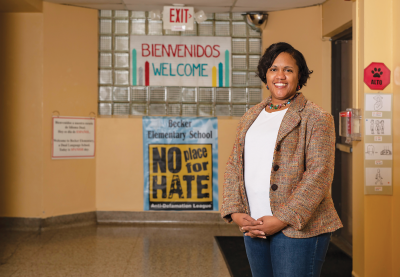Since 2010, Angela Ward has worked to promote cultural proficiency and inclusiveness in Austin Independent School District (ISD). Ward spoke with TT about her work providing the resources, training and support that educators and district staff need to serve every student in every classroom.
Can you tell us about your cultural proficiency work as administrative supervisor of race equity?
The goal of the Office of Cultural Proficiency and Inclusiveness is to support the development of the staff at Austin ISD ... as well as to create school spaces that are identity-affirming for students. And so our work centers around helping our adults understand that they are unique beings and—because of that—they come into their work with certain ways of viewing the world. Their worldview often colors how they are able to support students. So we help staff get in touch with who they are, what their values are, what their biases are, what their beliefs are and, ultimately, how all of those things impact their ability to be successful with students every day in our schools.
What does a day look like for you?
It will look like coaching sessions with principals, with department leads, with district leaders, with parents, with teachers, you name it. There’s no day that looks the same. I do a lot of work with community partners, and so I check in with community partners periodically. Right now, what my days look like are planning for our culturally responsive restorative practices work. ... It’s stopping by campuses and having conversations with principals, helping them think through how to structure professional learning for their staff ... around issues of differences stemming from race or gender identity, gender expression, religious differences, you name it. Anything that has to do with identity and who we are as human beings shows up in my work daily.
For those who don’t know about restorative practices, would you offer a brief explanation of what that means?
Restorative practices have been popularized by the criminal justice system, so often people will call it restorative justice. But in Austin ISD, we are taking a step back from that and recognizing the Indigenous roots of restorative practices. We are not saying justice is not a part of it, but it is not the practice; it is a part of the practice. ... When we talk about restorative practices, we talk about community building. We’re talking about using practices that affirm people as human beings, as unique human beings. We’re talking about practices that create space in schools for the environment to be welcoming, safe and inclusive for anyone, no matter how they identify, no matter what their values or beliefs are.
The most visible piece of restorative practices is the circle process. We use the circle process to meet and to give space for individual voice. We use the circle process also, so that all feel that they are seen and heard at some point during the school day. ... We talk about restorative practices as a way to build community, as a way to connect with each other and to help us to learn how to communicate with each other and build trusting relationships. So when conflict does occur, we are able to repair relationships because we took the time to build trusting relationships before the conflict happened.
What are some challenges you face in your work with educators?
In many cases, people don’t even know that they need to adapt the way that they are engaging in the world. ... A lot of that has to do with willingness and awareness of the need. ... I try to help people find ways to empathize [and] to get people to think differently about their work. It’s more than just whatever your job role is. If you’re a teacher, if you’re an administrator, if you’re a person who does paperwork all day and looks at spreadsheets, your spreadsheets are impacting a child in a classroom in every single school that exists in our school system. So what does that mean if you’re not even thinking about that work from that standpoint?
How can educators help build these values with colleagues?
They have to find something their colleagues believe and value. That is the starting point. ... If someone doesn’t want to talk about race, but they want to talk about poverty, then that is where you start. Then you ease into the ... intersections of race and poverty. You look at data and you have conversations around something to give them a new perspective. We do a lot of work around having dialogue that helps staff understand multiple perspectives.
What is a joy of your work?
Working with staff who really want to have this conversation about difference and how to make students feel safe, welcomed and included no matter how they come into this world and how they navigate the world. So I get joy from seeing people find their voice, find their footing in this conversation. ... I find joy in listening to people talk about their new understanding and their new learning. And I see the impact in the way that our students are being supported in their spaces.
Angela Ward is administrative supervisor of race equity and oversees the Office of Cultural Proficiency and Inclusiveness in Austin Independent School District in Texas.
Know an excellent administrator, librarian or counselor we should interview?
Tell us all about them.
